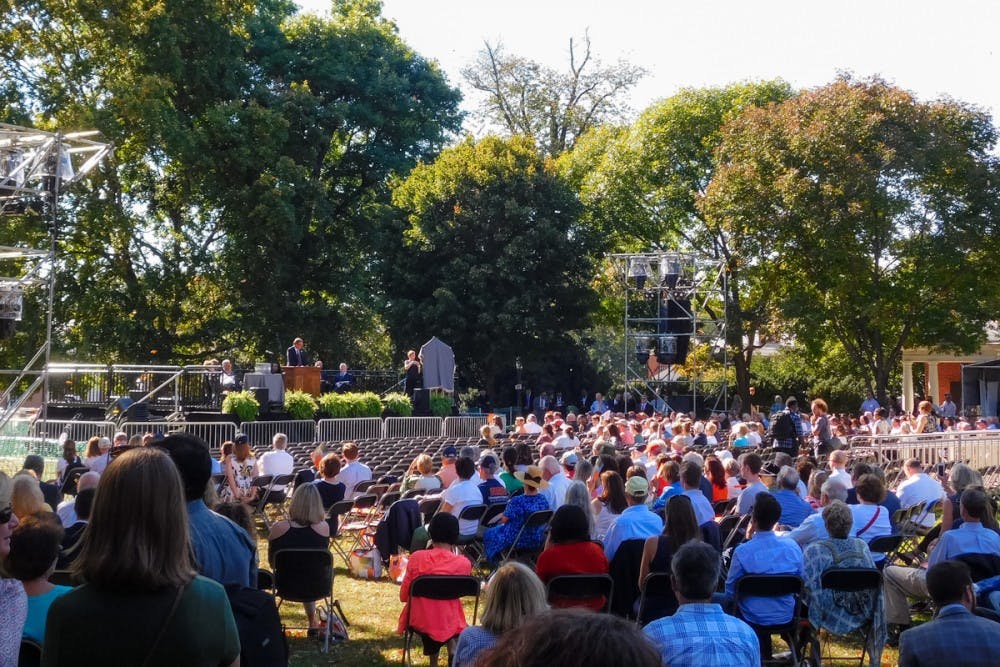In celebration of the University’s 200th year, the Bicentennial Commission held a “Tribute to the Laying of the Cornerstone” and “A Historical Perspective of the 1817 Ceremony” Friday. The latter, held on Monroe Hill, discussed the history of Monroe Hill and Freemasonry’s connection to the University. At the tribute to the laying of the cornerstone, Gov. Terry McAuliffe and University President Teresa Sullivan delivered remarks.
Other events organized in celebration of the University’s Bicentennial included a concert, several forums and presentations by a variety of speakers.
Over a hundred people attended the talk about the 1817 ceremony at Monroe Hill, at which Freemasons Jeffery E. Hodges and Mark Stephen Chapman spoke about the history of Freemasonry in Virginia.
U.S. Presidents Thomas Jefferson, James Madison and James Monroe attended the original ceremony in 1817, at which the Masons participated in laying the cornerstone of the University.
Hodges spoke about the origins of Freemason titles in the English bureaucracy, the importance of the Freemason symbols of squares and compasses and the history of Freemasons in the United States.
“First and foremost, what I’d like for you to realize is that we are a fraternity,” Hodges said. “Now most of you know fraternities because they’re Greek letter fraternities that you have on campus. Well, we’re not a fraternity like that … Instead I want you to think about the fact that we are an organization of men that is a brotherhood under the fatherhood of God.”
Chapman also presented a print of their lodge’s forecloth — a canvas on which symbols of masonry are inscribed to frame discussion at lodge meetings — as a gift for the University’s Bicentennial.
“Masons have been supporting education for a long time,” Chapman said. “For many years, they have given scholarships annually to local high school students. As I thought of how Masons might support this bicentennial celebration, I entertained the thought that a gift associated with the time period of our lodges laying the cornerstone of [Central College] would be appropriate, and we have just such a gift.”
After the Freemasons spoke, John Costello, a Class of 2017 alumnus and Medical student, took over the podium to give a brief history of Monroe Hill. Along with a team of undergraduate Brown College students, Costello is conducting ongoing research into the history of Monroe Hill.
“We are moving toward a publication, and we’re hoping to get that out by the end of next semester,” Costello said.
Following the celebration of the 1817 ceremony, the University hosted the tribute to the laying of the cornerstone on the Lawn. The University’s cornerstone, located in Pavilion VII, was laid Oct. 6, 1817.
Sullivan said the University transformed from Jefferson’s dream to a reality, and mentioned the revolutionary historical times during which the University was founded.
“These two bold experiments — the American Republic and the University of Virginia — were connected at the beginning and remain connected now,” Sullivan said.
McAuliffe shared Sullivan’s sentiment and thanked the students who have contributed to the University over the years.
“Time and time again, the University of Virginia has been a leader. Thomas Jefferson set that in motion 200 years ago,” McAuliffe said. “You have made our state such a special place. We have had our ups and downs in our commonwealth.”
Like McAuliffe, Bryanna Miller, the Student Member of the University’s Board of Visitors and fourth-year College student, said she believed the student body is what makes the University exceptional.
“There is no limit to what our students can accomplish in this world,” Miller said. “I implore all of us to trust the students of the future, the students of the class of 2119, to carry this institution forward and make it a place that we can’t imagine because it’s just that beautiful.”
To commemorate the laying of the cornerstone, University Rector Frank M. “Rusty” Conner III presented a plaque, which honored the University’s “commitment to advance the human experience and ensure the flourishing of democracy.”





